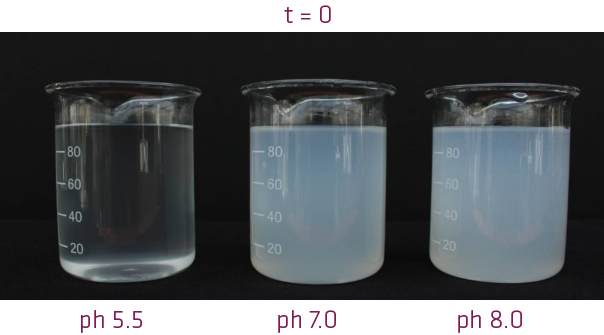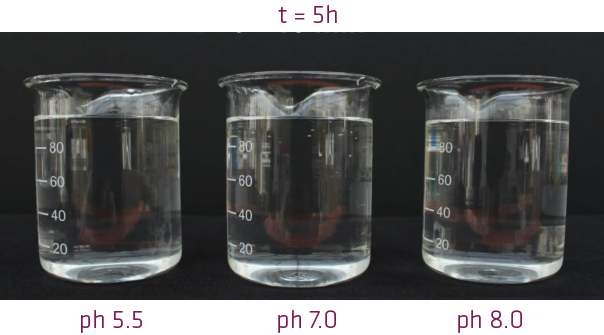Quick absorption
Tolerance
Good solubility
Good miscibility
High stability
High cost-effectiveness
Zn sulphate compared with Zn chelate

ZnSO4 · 7H2O (0.3% w/w aqueous solution)
Solubility is pH-dependent. Even neutral or slightly basic pH prevents the production of a homogeneous solution. The photos were taken immediately after preparation.

ZnSO4 · 7H2O (0.3% w/w aqueous solution)
Solubility is pH-dependent. Even neutral or slightly basic pH prevents the production of a homogeneous solution. The photos were taken 15 minutes after preparation.
 ADOB® 2.0 Zn IDHA (0.3% w/w aqueous solution)
ADOB® 2.0 Zn IDHA (0.3% w/w aqueous solution)The Zn-chelate solution remains clear regardless of the solution pH, even 5 hours after preparation.
A comparison between chelated and non-chelated micronutrients in high pH solutions
Chelated micronutrients
Chelated Zn, e.g. Zn-HBED
In high pH solution, chelated zinc is fully protected against the reactive hydroxyl anions (OH–). All the Zn2+ contents will be taken up by the plant.
Non-chelated micronutrients
Crystalline Zn salt, e.g. ZnSo4
In high pH solutions, zinc cations are not protected, so under the attack of hydroxyl anions (OH–) they will rapidly precipitate in the form of zinc hydroxide Zn(OH)2, resulting in Zn unavailability to plant roots or leaves.
A comparison between chelated and non-chelated micronutrients under tank mixing with phosphate fertilisers such as NPK, MAP or MKP
Chelated micronutrients
Chelated Mn, e.g. Mn-DTPA
Manganese cations in the manganese chelate are fully protected against the reactive phosphate anions (PO43–). All the Mn2+ contents will be taken up by the plant.
Non-chelated micronutrients
Crystalline Mn salt, e.g. MnSO4
Manganese cations are not protected, so under the attack of phosphate anions (PO43–), all the Mn2+ contents will leave the solution in the form of manganese phosphate Mn3(PO4)2 precipitate, resulting in Mn unavailability to plant roots or leaves.
Application recommendations
Preferences of ADOB®’s chelated products, based on soil pH, chelate type and deficient nutrient
Scroll left/right to see more
| Soil pH | IDHA | EDTA | DTPA | HBED | ||||
|---|---|---|---|---|---|---|---|---|
| Fe | Cu, Zn, Mn | Fe | Cu, Zn, Mn | Fe | Cu, Zn, Mn | |||
| <6.5 | +++ | +++ | +++ | +++ | + | + | – | |
| 6.5-7.5 | – | ++ | – | ++ | +++ | +++ | + | |
| >7.5 | – | + | – | + | – | – | +++ | |
Preferences of ADOB®’s chelated products, based on application method
Scroll left/right to see more
| Method of fertilisation | IDHA | EDTA | DTPA | HBED |
|---|---|---|---|---|
| Foliar | +++ | +++ | – | – |
| Soil | ++ | ++ | +++ | +++ |
| Fertigation | ++ | ++ | +++ | +++ |
| Hydroponics | ++ | ++ | +++ | ++ |

